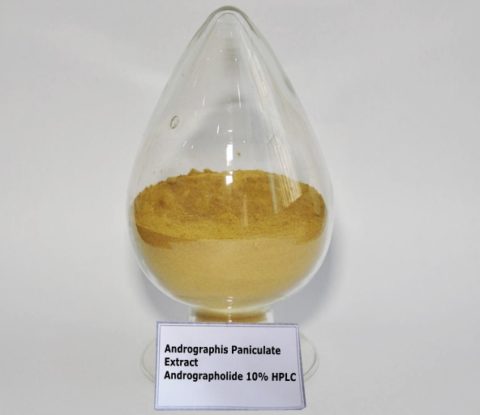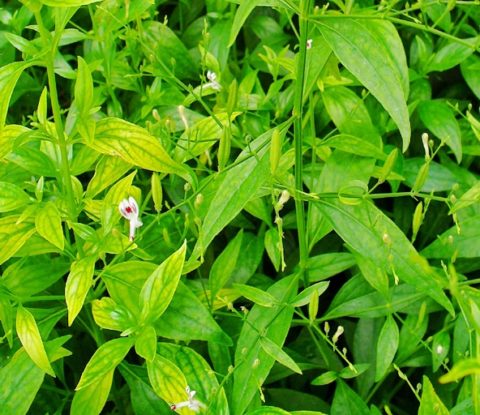
Andrographis Paniculate Extract
【Botanical Source】:Andrographis Paniculata(Burm.F.) Nees
【Plant Part Used】:Whole Herb
【Extract Solvent】:Ethanol
【Active ingredient】:Andrographolide
【CAS NO.】:5508-58-7
【Specification】:10% 20% 30% 50% 98%, 10:1, 20:1
【Test Method】:HPLC and TLC
【Appearance】: <50% Brownish yellow fine powder;>50% Colorless crystal power
Description
Andrographis paniculata is an annual herbaceous plant in the family Acanthaceae, native to India and Sri Lanka. It is widely cultivated in Southern and Southeastern Asia, where it has been traditionally used to treat infections and some diseases. Mostly the leaves and roots were used for medicinal purposes. The whole plant is also used in some cases. Andrographis is frequently used for preventing and treating the common cold and flu (influenza). Some people claim andrographis stopped the 1919 flu epidemic in India, although this has not been proven.
Andrographis is also used for a wide assortment of other conditions. It is used for digestive complaints including diarrhea, constipation, intestinal gas, colic, and stomach pain; for liver conditions including an enlarged liver, jaundice, and liver damage due to medications; for infections including leprosy, pneumonia, tuberculosis, gonorrhea, syphilis, malaria, cholera, leptospirosis, rabies, sinusitis, and HIV/AIDS; and for skin conditions including wounds, ulcers and itchiness. Some people use andrographis for sore throat, coughs, swollen tonsils, bronchitis, and allergies. It is also used for “hardening of the arteries” (atherosclerosis), and prevention of heart disease and diabetes. Other uses include treatment of snake and insect bites, loss of appetite, kidney problems (pyelonephritis), hemorrhoids, and an inherited condition called familial Mediterranean fever. Andrographis is also used as an astringent, bacteria killing agent, painkiller, fever reducer, and treatment for worms.
Andrographolide is the major constituent extracted from the leaves of the plant and is a bicyclic diterpenoid lactone. This bitter principle was isolated in pure form by Gorter (1911). Andrographolide is a labdane diterpenoid that has been isolated from the stem and leaves of Andrographis paniculata. Andrographolide is an extremely bitter substance. Andrographolide has been studied for its effects on cell signaling, immunomodulation, and stroke. Study has shown that andrographlide may bind to a spectrum of protein targets including NF-κB and actin by covalent modification.
Pharmacological Benefits
Antimicrobial Effect
Andrographis Extracts and andrographolide derivatives have shown modest activity in vitro against HIV(Basak A , Cooper S , Roberge AG , Banik UK , Chrétien M , Seidah NG . Inhibition of proprotein convertases-1, -7 and furin by diterpines of Andrographis paniculata and their succinoyl esters. Biochem J . 1999;338(pt 1):107-113.); however, a phase 1 study of andrographolide showed no effect on viral replication after 6 weeks, despite increased CD4 counts(Calabrese C , Berman SH , Babish JG , et al. A phase I trial of andrographolide in HIV positive patients and normal volunteers. Phytother Res . 2000;14(5):333-338.). Activity in antimalarial screens has also been noted for Andrographis extracts, but clinical trials are lacking.
Andrographis Extract blocked Escherichia coli enterotoxin-induced secretion in rabbit and guinea pig models of diarrhea. Andrographolide and 3 other related diterpenes were responsible for this action. Other in vitro experiments present conflicting results for the action of andrographolide and leaf extracts on E. coli.(Singha PK , Roy S , Dey S . Antimicrobial activity of Andrographis paniculata . Fitoterapia . 2003;74(7-8):692-694.)
Anti-cancer Effect
Animal and in vitro experiments using human cancer cell lines to investigate the potential anticancer effects of Andrographis paniculata have found andrographolide responsible for the observed effects rather than other diterpenes. Various mechanisms of action have been proposed, including enhancement of chemokine activity, inhibition of tumor-specific angiogenesis affecting cell cycle progression, and induction of apoptosis. Cancer cell lines investigated include prostate, breast, cervical, colon, hepatoma, melanoma, and lymphocytic leukemia. Researchers are now focusing on synthesizing compounds based on andrographolide to improve selectivity and potency(Nanduri S , Nyavanandi VK , Thunuguntla SS , et al. Synthesis and structure-activity relationships of andrographolide analogues as novel cytotoxic agents. Bioorg Med Chem Lett . 2004;14(18):4711-4717.).
The need for caution has been raised by one group of researchers because andrographolide-enhanced SDF-1-chemokine activity might induce tumor cell metastasis. Andrographis paniculata extract has also induced cell differentiation in mouse myeloid leukemia cells(Matsuda T , Kuroyanagi M , Sugiyama S , Umehara K , Ueno A , Nishi K . Cell differentiation-inducing diterpenes from Andrographis paniculata Nees. Chem Pharm Bull . 1994;42(6):1216-1225.).
Immunostimulant Effect
Animal data
Both antigen-specific and antigen-nonspecific immune responses in mice were stimulated by andrographolide and an ethanolic extract; the extract was more potent than andrographolide, suggesting that other constituents also were immunostimulants. Inhibition of passive cutaneous anaphylaxis and mast cell stabilization was observed in studies of the purified diterpenes in rats(Gupta P , et al. Antiallergic activity of andrographolides isolated from Andrographis paniculata (Burm. f.) Wall. Pharm Biol . 1998;36:72-74.).
Clinical data
A systematic review of 4 clinical trials found A. paniculata , either alone or in a fixed combination with A. senticosus ( Kan Jang ), significantly more effective than placebo ( P < 0.0001 and P = 0.0002, respectively) in reducing the severity of upper respiratory tract infections and related symptoms. The review found a lack of outcome consistency in the included studies. Other clinical trials have demonstrated similar results for respiratory infections, but methodology in these trials is of poor quality(Spasov AA , Ostrovskij OV , Chernikov MV , Wikman G . Comparative controlled study of Andrographis paniculata fixed combination, Kan Jang and an Echinacea preparation as adjuvant, in the treatment of uncomplicated respiratory disease in children. Phytother Res . 2004;18(1):47-53.).
A small study in patients with familial Mediterranean fever (N = 24) found a decrease in frequency, duration, and severity of febrile attacks, compared with placebo(Amaryan G , Astvatsatryan V , Gabrielyan E , Panossian A , Panosyan V , Wikman G . Double-blind, placebo-controlled, randomized, pilot clinical trial of lmmunoGuarda —a standardized fixed combination of Andrographis paniculata Nees, with Eleutherococcus senticosus Maxim, Schizandra chinensis Bail. and Glycyrrhiza glabra L. extracts in patients with Familial Mediterranean Fever. Phytomedicine . 2003;10(4):271-285.). Stimulation of the production of key cytokines and immune activation markers has been investigated as potential mechanisms of andrographolide immunomodulation(Zhang XF , Tan BK . Anti-diabetic property of ethanolic extract of Andrographis paniculata in streptozotocin-diabetic rats. Acta Pharmacol Sin . 2000;21(12):1157-1164.).
Anti-Inflammatory Effects
Andrographolide has been reported to significantly reduce the inflammation caused by histamine, dimethyl benzene, and adrenaline. Overproduction of NO and prostaglandin E2 (PGE2), because of the expression of inducible isoforms of nitric oxide synthase (iNOS) and cyclooxygenase-2 (COX-2), plays a significant role in the inflammatory processes of activated macrophages. The secretion of proinflammatory cytokines from macrophages stimulated and promoted by lipopolysaccharide, which causes induction of iNOS, results in increased production of NO. The methanol extract of A. paniculata and andrographolide incubated with macrophages have been reported to inhibit LPS-stimulated NO production in a concentration-dependent manner. Chiou et al.(W. F. Chiou, C. F. Chen, and J. J. Lin, “Mechanisms of suppression of inducible nitric oxide synthase (iNOS) expression in RAW 264.7 cells by andrographolide,” British Journal of Pharmacology, vol. 129, no. 8, pp. 1553–1560, 2000.) observed that andrographolide inhibits lipopolysaccharide-induced nitric oxide (NO) production and inducible NO synthase (iNOS) expression in the murine macrophage-like cell line RAW 264.7. Administering andrographolide to rats fully restored the maximal contractile response of the thoracic aorta to phenylephrine after incubation with LPS and alleviated the decrease in the mean arterial blood pressure of anesthetized rats. Andrographolide has also been reported to suppress IL-2 production and T-cell proliferation in a mixed lymphocyte reaction and to inhibit dendritic cell maturation and antigen presentation(M. I. Iruretagoyena, S. E. Sepúlveda, J. P. Lezana et al., “Inhibition of nuclear factor-κB enhances the capacity of immature dendritic cells to induce antigen-specific tolerance in experimental autoimmune encephalomyelitis,” The Journal of Pharmacology and Experimental Therapeutics, vol. 318, no. 1, pp. 59–67, 2006.).
Hepatoprotective Effect
Liver diseases of various origins remain a serious health problem and a major cause of mortality. In the absence of reliable hepatoprotective drugs in modern medicine, herbs and plants play a vital role in managing several liver disorders (P. K. Mukherjee, Quality Control on Herbal Drugs, Business Horizons, New Delhi, India, 1st edition, 2002.). Extensive literature related to the hepatoprotective activity of molecules from herbal sources shows that there is a vast array of molecules exhibiting potent hepatoprotective efficacy. The Indian systems of medicine have long used A. paniculata as a hepatostimulant and hepatoprotective agent. A. paniculata is also an ingredient in several polyherbal preparations used as hepatoprotectants , one of which has been reported to be efficacious in chronic hepatitis B viral infection. A recent study showed that andrographolide attenuated concanavalin A-induced liver injury and inhibited hepatocyte apoptosis. Shukla et al. (B. Shukla, P. K. S. Visen, G. K. Patnaik, and B. N. Dhawan, “Choleretic effect of andrographolide in rats and guinea pigs,” Planta Medica, vol. 58, no. 2, pp. 146–149, 1992.) reported observing choleretic effects of andrographolide in conscious rats and anesthetized guinea pigs. The effect of andrographolide was found to be more potent than silymarin against acetaminophen-induced reduction of the volume and contents of bile. Andrographolide was also shown to protect against ethanol-induced hepatotoxicity in mice with an equivalent efficacy of silymarin(P. K. Singha, S. Roy, and S. Dey, “Protective activity of andrographolide and arabinogalactan proteins from Andrographis paniculata Nees. against ethanol-induced toxicity in mice,” Journal of Ethnopharmacology, vol. 111, no. 1, pp. 13–21, 2007. ). Oral pre- and posttreatments of adult rats with an extract of A. paniculata were protective against an ethanol-induced increase in serum transaminases. A protective effect of a single oral dose each of the extract and of andrographolide has been studied in carbon tetrachloride- (CCl4-) induced hepatic microsomal lipid peroxidation. Rana and Avadhoot (A. C. Rana and Y. Avadhoot, “Hepatoprotective effects of Andrograhphis paniculata against carbon tetrachloride-induced liver damage,” Archives of Pharmacal Research, vol. 14, no. 1, pp. 93–95, 1991.) reported the hepatoprotective effects of the crude alcohol extract of leaves against CCl4-induced liver damage; these effects have had also been established against paracetamol-induced toxicity in an ex vivo rat model of isolated hepatocytes. Plant extracts of A. paniculata showed hepatoprotective characters consistent.




